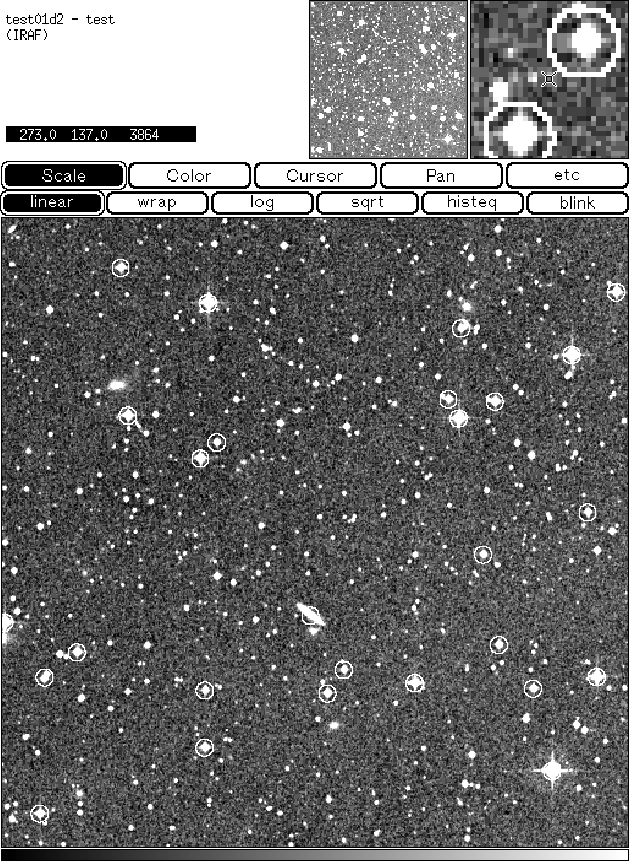




 784 kB PostScript reprint
784 kB PostScript reprint
Next: GUIDARES: Reading the
Up: Archives and Databases
Previous: Exploring Interactive Archive
Astronomical Data Analysis Software and Systems IV
ASP Conference Series, Vol. 77, 1995
Book Editors: R. A. Shaw, H. E. Payne, and J. J. E. Hayes
Electronic Editor: H. E. Payne
J. E. Morrison
Space Telescope Science Institute, 3700 San Martin Drive, Baltimore MD 21218
Abstract:
The Digitized Sky Survey is now available on CD-ROMs and will be on
the ST ScI archive. This is a whole sky survey constructed from the
Palomar E and SERC J Schmidt surveys. We present an overview of
software produced by the ST ScI STSDAS group to access and manipulate these
images. We have developed portable code to use in the IRAF
environment, hopefully in the future this we be available as a stand alone package.
ST ScI has digitized Schmidt plates of the entire Sky. Due to the massive
volume of data involved (a total of about 600 Gbytes) the scans have
been compressed by a factor of 10 and are made available in the form of 100
CD-ROMs. Software to give the astronomical community access to these
scans is being developed by the STSDAS and Guide Stars groups at ST ScI.
The northern-hemisphere data are from scans of the E plates of the
National Geographic Society -- Palomar Observatory Sky Survey (NGS-POSS)
obtained using the Oschin Telescope on Palomar Mountain. These plates
are deep 103a-E exposures obtained through a red plexiglass filter.
The southern-hemisphere plates were obtained using the UK Schmidt
Telescope while it was operated by the Royal Observatory Edinburgh
(ROE). These are deep IIIa-J exposures obtained through a GG 395 filter.
The scans were made at the Space Telescope Science Institute using the
scanning microdensitometers, which are described in Lasker et al. (1990).
A pixel size of 25micron with a 50micron apodized
aperture was used throughout.
The original plate images were composed of 14,000 by 13,999 pixels (a pixel
is 1.70 arcseconds square). To allow fast access to any portion of the
plate, the image was divided into blocks of 500 by 500 pixels that were
separately compressed by a factor of ten. Experiments
to study the degradation of astrometry on the compressed images compared
to the original image were performed by White et al. (1992), who
concluded that
the astrometry is hardly affected by the compression for modest compress
factors (up to about a factor of 20).
The software to read the compressed images is provided with the set of CD
ROMs and is also a new task in the GASP/STSDAS package called
getimage.
In the getimage software the user specifies the region of interest. The
software then accesses the data, decompresses the scans and returns the
data in a form of a photographic intensity as a function of x and y plate
pixel coordinates.
New tasks are being added to the GASP package that will allow the user
to manipulate this data. At this time these tasks use the original plate
parameters produced by a single global model reduction of the plates. In
the foreseeable future the astrometry will use a more sophisticated
method.
- getimage
- accesses the Digitized Sky Survey (DSS) CD ROMs and
decompressed the data returning a photographic intensity as a function
of x and y pixel coordinates. This software package is available on the
CD ROM set and was written by Jesse Doggett and placed into GASP/STSDAS
by Allen Farris.
- dss_targets
- extracts Guide Star Catalog (GSC) stars from the CD-ROM
Guide Star Catalog in the field specified by the user and overlays the
these stars on an DSS image produced by getimage.
- dss_pxcoord
- given a table of GSC stars (or other table of equatorial
coordinates) finds the pixel coordinates corresponding to the DSS image.
- dss_xyeq
- procedure to calculate the equatorial coordinates from a set
of (x,y) pixels using the original plate parameters.
- dss_eqxy
- procedure to calculate the pixel coordinates from a set of
equatorial coordinates using the original plate parameters.

Figure: An image from the Digitized Sky Survey: center (0.h 0, -89.o 0),
and size: 0.o 2. Produced by getimage and dss_targets tasks.
Getimage was used to extract the data, while dss_targets was
used to display the image,
search the Guide Star Catalog for stars in the region, and then plot
white circles around the GSC stars found in the image.
Original PostScript figure (738 kB)
Acknowledgments:
I would like to acknowledge Jeffrey Hayes, Brian McLean, and Jesse Doggett
for their scientific assistance.
References:
Lasker, B., Sturch, C. R., McLean, B. J., Russell, J. L., &
Jenkner, H. 1990, AJ, 99, 2019
White, R. L., Postman, M., & Lattanzi, M. G. 1992, Digitized Optical Sky Surveys, 167





 784 kB PostScript reprint
784 kB PostScript reprint
Next: GUIDARES: Reading the
Up: Archives and Databases
Previous: Exploring Interactive Archive
adass4_editors@stsci.edu
